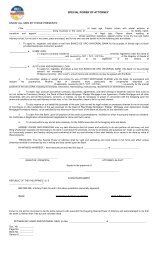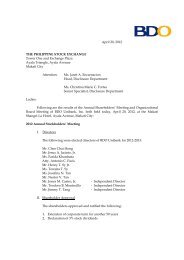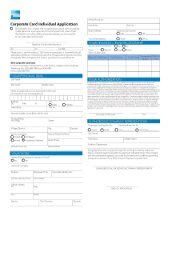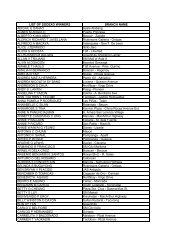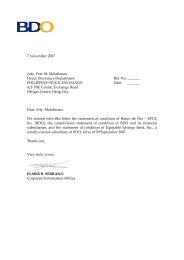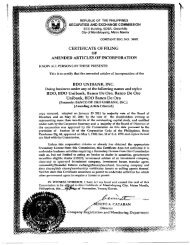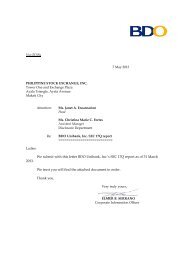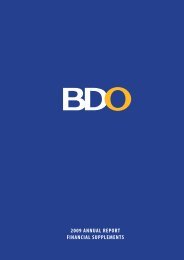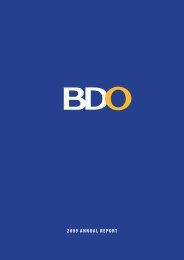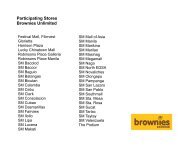Notes to Financial Statements - BDO
Notes to Financial Statements - BDO
Notes to Financial Statements - BDO
Create successful ePaper yourself
Turn your PDF publications into a flip-book with our unique Google optimized e-Paper software.
<strong>Notes</strong> <strong>to</strong> <strong>Financial</strong> <strong>Statements</strong>DECEMBER 31, 2008, 2007 AND 2006(Amounts in Millions Except Per Share Data)If the Group fails <strong>to</strong> keep these investments at maturity (other than for the allowed specific circumstances, e.g., selling more than aninsignificant amount close <strong>to</strong> maturity), it will be required <strong>to</strong> reclassify the entire class <strong>to</strong> AFS securities. The investments would thereforebe measured at fair value and not at amortized cost. However, the tainting provision will not apply if the sales or reclassifications ofHTM investments: (i) are so close <strong>to</strong> maturity or the financial asset’s call date that changes in the market rate of interest would not havea significant effect on the financial asset’s fair value; (ii) occur after the Group has collected substantially all of the financial asset’soriginal principal through scheduled payments or prepayments; or, (iii) are attributable <strong>to</strong> an isolated event that is beyond the control ofthe Group, is nonrecurring and could not have been reasonably anticipated by the Group.If the entire class of held-<strong>to</strong>-maturity investments is tainted, the unrealized fair value would decrease by P4,264 in the Group financialstatements and decrease by P4,181 in the Parent Bank financial statement, with a corresponding entry in the Fair Value Loss on Availablefor-saleSecurities account in the statement of changes in equity.(b)Impairment of Available-for-Sale <strong>Financial</strong> AssetsThe Group follows the guidance of PAS 39, <strong>Financial</strong> Instruments: Recognition and Measurement, in determining when an investment ispermanently impaired. This determination requires significant judgment. In making this judgment, the Group evaluates, among otherfac<strong>to</strong>rs, the duration and extent <strong>to</strong> which the fair value of an investment is less than its cost; and the financial health of and near-termbusiness outlook for the investee, including fac<strong>to</strong>rs such as industry and sec<strong>to</strong>r performance, changes in technology and operational andfinancing cash flow. For investments issued by counterparty under bankruptcy, the Group determines permanent impairment based onthe price of the most recent transaction and on latest indications obtained from reputable counterparties (which regularly quote pricesfor distressed securities) since current bid prices are no longer available.In 2008, the Group recognized a <strong>to</strong>tal of P4,440 provision for impairment losses on available-for-sale securities in the income statement(nil in 2007) (see Note 9.2).(c)Distinction Between Investment Properties and Owner-occupied PropertiesThe Group determines whether a property qualifies as investment property. In making its judgment, the Group considers whether theproperty generated cash flows largely independently of the other assets held by the Group. Owner-occupied properties generate cashflows that are attributable not only <strong>to</strong> other assets used in the production or supply process.Some properties comprise a portion that is held <strong>to</strong> earn rental or for capital appreciation and another portion that is held for use in theproduction and supply of goods and services or for administrative purposes. If these portions can be sold separately (or leased outseparately under finance lease), the Group accounts for those portions separately. If the portion cannot be sold separately, the propertyis accounted for as investment property only if an insignificant portion is held for use in the production or supply of goods or servicesfor administrative purposes. Judgment is applied in determining whether ancillary services are so significant that a property does notqualify as investment property. The Group considers each property separately in making its judgment.(d)Operating and Finance LeasesThe Group has entered in<strong>to</strong> various lease agreements either as a lessor or lessee. Critical judgment was exercised by management <strong>to</strong>distinguish each lease agreement as either an operating or finance lease by looking at the transfer or retention of significant risks andrewards of ownership of the properties covered by the agreements.(e)Classification of Acquired Properties and Fair Value Determination of Non-current Assets Held for Sale and Investment PropertyThe Group classifies its acquired properties as Premises, Furniture, Fixtures and Equipment if used in operations, as Non-current AssetsHeld-for-sale if the Group expects that the properties will be recovered through sale rather than use, as Investment Property if theGroup intends <strong>to</strong> hold the properties for capital appreciation or as <strong>Financial</strong> Assets in accordance with PAS 39. At initial recognition, theGroup determines the fair value of acquired properties through internally and externally generated appraisal. The appraised value isdetermined based on the current economic and market conditions as well as the physical condition of the property.(f)Provisions and ContingenciesJudgment is exercised by management <strong>to</strong> distinguish between provisions and contingencies. Policies on recognition and disclosure ofprovision are discussed in Note 2.18 and relevant disclosures are presented in Note 31.3.2 Key Sources of Estimation UncertaintyThe following are the key assumptions concerning the future, and other key sources of estimation uncertainty at the statement of conditiondate, that have a significant risk of causing a material adjustment <strong>to</strong> the carrying amounts of resources and liabilities within the next financialyear:(a)Impairment losses on financial assets (AFS securities, HTM investments and loans and receivables)The Group reviews its AFS, HTM and loans and receivables portfolios <strong>to</strong> assess impairment at least on a quarterly basis. In determiningwhether an impairment loss should be recorded in the income statement, the Group makes judgments as <strong>to</strong> whether there is anyobservable data indicating that there is a measurable decrease in the estimated future cash flows from the portfolio before the decreasecan be identified with an individual item in that portfolio. This evidence may include observable data indicating that there has been anadverse change in the payment status of borrowers or issuers in a group, or national or local economic conditions that correlate withdefaults on assets in the group. Management uses estimates based on his<strong>to</strong>rical loss experience for assets with credit risk characteristicsand objective evidence of impairment similar <strong>to</strong> those in the portfolio when scheduling its future cash flows. The methodology andThinking Ahead To Get You Ahead • Annual Report 2008 23



